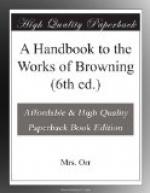[Footnote 107: Some expressions in this Idyl may require explaining. “Salomo si nosset” (novisset) (p. 136). “Had Solomon but known this.” “Teneo, vix” (p. 136). “I scarcely contain myself.” “Hact[=e]nus” (p. 136). The “e” is purposely made long. “Hitherto.” “Peason” (p. 138). The old English plural of “pea.” “Pou sto” (p. 138). “Where I may stand:” The alleged saying of Archimedes—“I could move the world had I a place for my fulcrum—’where I might stand’ to move it.” “Tithon” (p. 141). Tithonus—Aurora’s lover: for whom she procured the gift of eternal life. “Apage, Sathanas!” (p. 143). “Depart Satan.” Customary adjuration.
The term “Venus,” as employed in the postscript to the Idyl, signified in Roman phraseology, the highest throw of the dice. It signified, therefore the highest promise to him, who, in obedience to the oracle, had tested his fortunes at the fount at Abano, by throwing golden dice into it. The “crystal,” to which Mr. Browning refers, is the water of the well or fount, at the bottom of which, as Suetonius declared, the dice thrown by Tiberius, and their numbers, were still visible. The little air which concludes the post-script reflects the careless or “lilting” mood in which Mr. Browning had thrown the “fancy dice” which cast themselves into the form of the poem.]
[Footnote 108: “If it is proper to be credited.”]
[Footnote 109: This version is more crudely reproduced by the Persian poet Jami.]
[Footnote 110: The word “conster,” which rhymes in the poem with “monster,” is Old English for “construe.”]
[Footnote 111: Daughter of Gustavus Adolphus, and Queen of Sweden.]
[Footnote 112: Some confusion has here arisen between Francis I., whose emblem was the salamander, and Henry II., the historic lover of Diane de Poitiers. But Francis was also said to have been, for a short time, attached to her; and the poetic contrast of the frigid moon and the fiery salamander was perhaps worth the dramatic sacrifice of Cristina’s accuracy.]
[Footnote 113: A village close to Fontainebleau, in the church of which Monaldeschi was buried.]
[Footnote 114: “Winged” or “fiery:” fiery from the rapidity of its motion.]
[Footnote 115: Juno.]
[Footnote 116: That is, to Moses Maimonides.]
[Footnote 117: The names and instances given are, as well as the main fact, historical.]
[Footnote 118: A Talmudic doctrine still held among the Jews. The “Halaphta,” with whom Mr. Browning connects it, was a noted Rabbi.]
[Footnote 119: The “Bier” and the “three daughters” was a received Jewish name for the Constellation of the Great Bear. Hence the simile derived from this (vol. xv. pp. 217-244).
The “Salem,” mentioned at p. 218, is the mystical New Jerusalem to be built of the spirits of the great and good.]
[Footnote 120: “Chetw. Hist. Collect.,” cent. I., p. 17. Quoted by Nath. Wanley, “Wonders of the Little World,” p. 138.]




